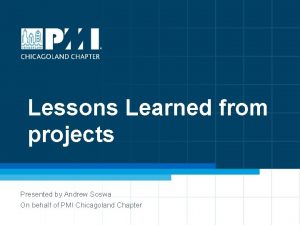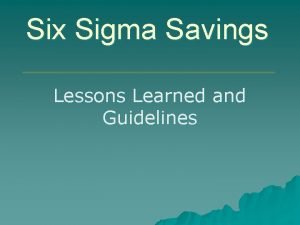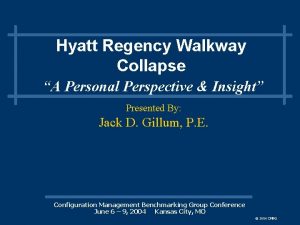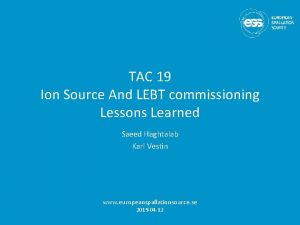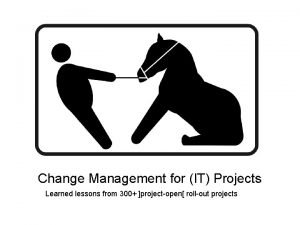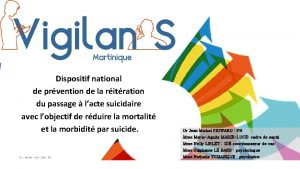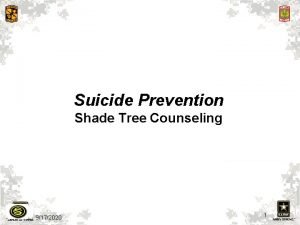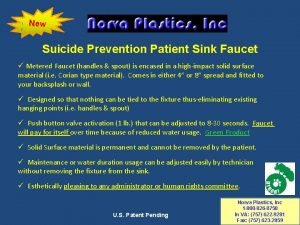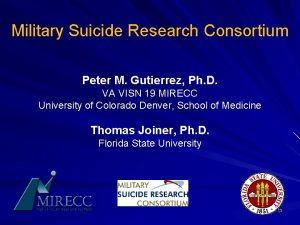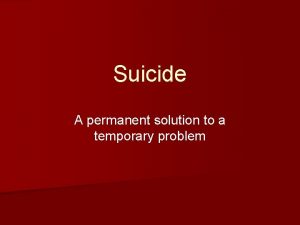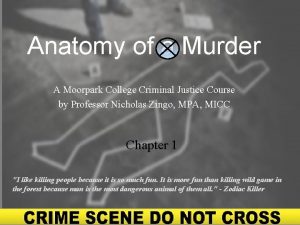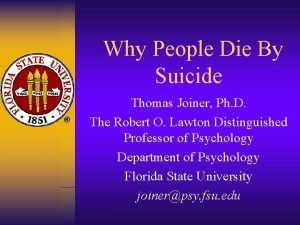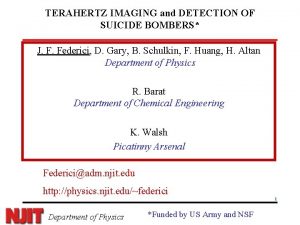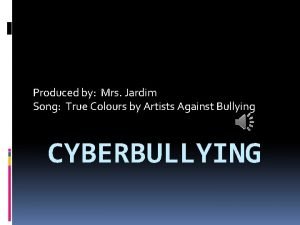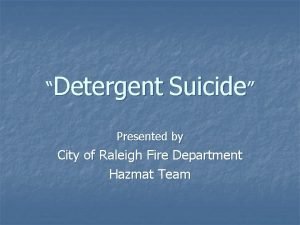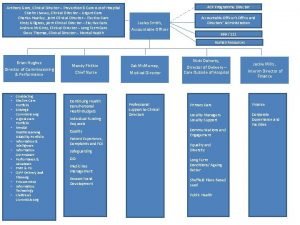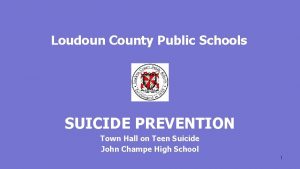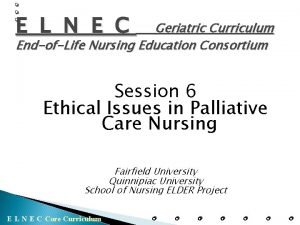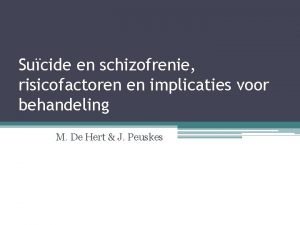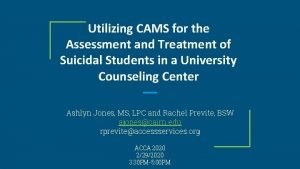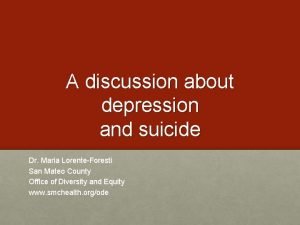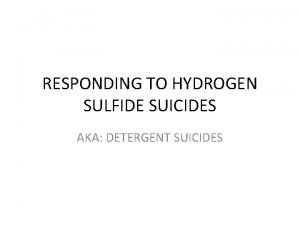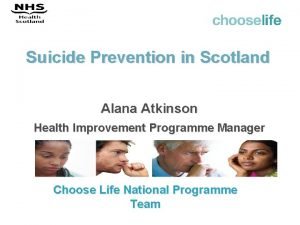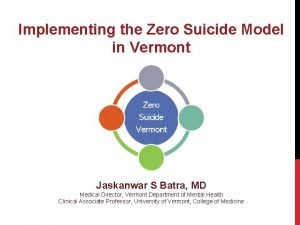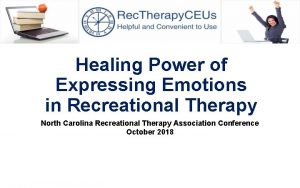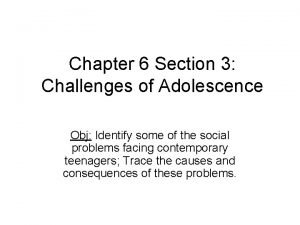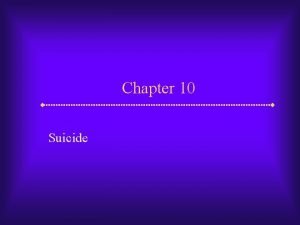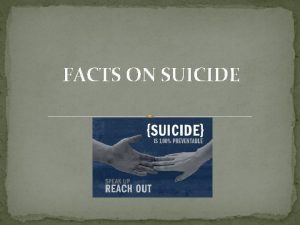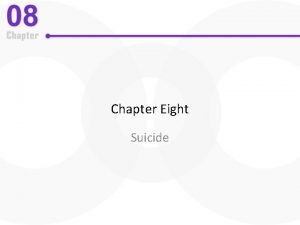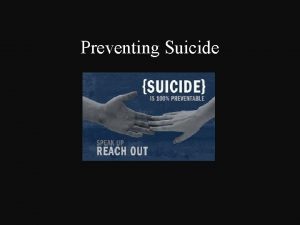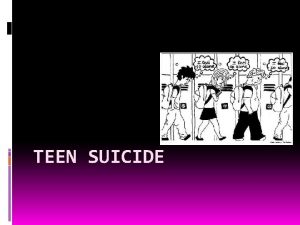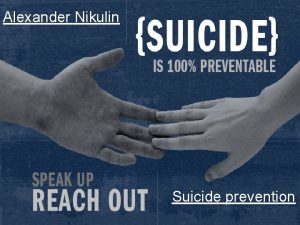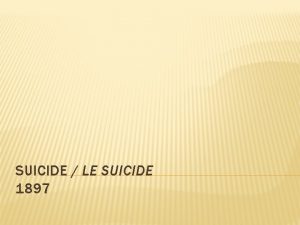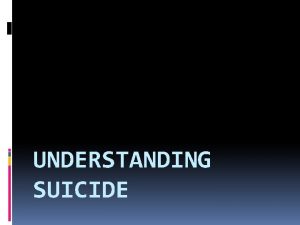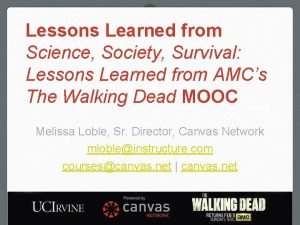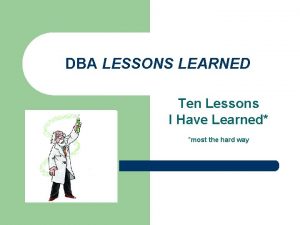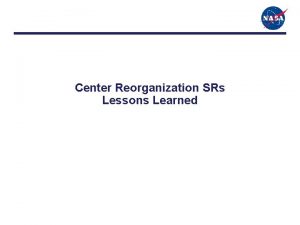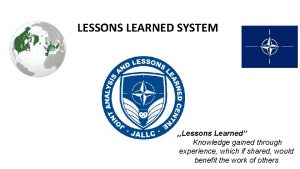Cop 2 Cop Suicide Lessons Learned An Overview
































































- Slides: 64

Cop 2 Cop Suicide Lessons Learned An Overview Cherie Castellano MA, CSW, LPC, AAETS

Cop 2 Cop Program History • First program of it’s kind in the country • Legislative law was passed (Bill 1801) • In July 2000, an agreement was signed between NJ DOP and UMDNJ-UBHC • Program “went live” on November 1, 2000 at 1 -866 -COP-2 COP

Governor’s Task Force on Police Suicide COP 2 COP Lessons Learned • • • COP 2 COP is nationally a “Best Practice”- MARKET Maintain focus on QPR for LE training/PTC Increase collaboration with Unions & constituency SOP’s can foster service provision as prevention High Risk populations must be identified annually 2009 - High Risk, Corrections Officers, Wounded/Disabled, Retired, Hx of MH problem, IA, Alcohol, relationship problems • 90% of NJ Cop suicide used firearms in analysis • Mental Health Stigma must be confronted


Cop 2 Cop - Who is it for? 1 -866 -Cop 2 Cop (1 -866 -267 -2267) – 51, 500+ Active NJ Law Enforcement Officers and their families – All retired and disabled NJ Law Enforcement Officers Free and Confidential • Cop 2 Cop is answered live 24/7 • Retired law enforcement officer always available and on call

Cop 2 Cop American Association of Suicidology Certification • April 2002 – 1 st and only Law Enforcement Crisis Intervention Program to be certified by AAS in the United States • Initial review-Score of 129 out of possible 144 – (90 minimum for certification) • October 2003 Random Site Visit reporting that Cop 2 Cop is functioning High above AAS standards • July 2005 – Re-Certification renewal/site visit – Score of 140 out of possible 144

Cop 2 Cop Hotline Statistics • 10/1/00 - 9/10/01 = 1, 762 9/11/01 300% call increase • 9/11/01 – To Date = 23, 000+ Approx. 3, 000 calls ANNUALLY • CISM Responses : 10/1/00 – To Date = 600+ • 159 Suicide Calls – 157 Subverted – 2 triaged • Gender breakdown: 70% - male, 30% female

Cop 2 Cop Staffing - 2009 1 Program Coordinator (Police Wife) 1 Cop Clinician ( Retired Law Enforcement officer/LPC/screener) 1 Mental Health Specialist Supervisor ( Retired Law Enforcement officer/clergy/corrections) 1 Mental Health Specialist ( Law Enforcement officer’s son) 8 Cop Peer Consultants (all Retired Law Enforcement officers) 1 Secretary/Administrative Coordinator 10 Volunteer Peer Supporters-Retired Law Enforcement Officers

Cop 2 Cop Peer Support 2009 -19 out of 21 of our staff are Police Peers (retired) All types FBI, Corrections, Chief, Municipal, Prosecutors, Parole, etc Telephone Peer Support - Trained in A. A. S. Crisis Call Model. COP ON CALL Calls, Callbacks, Case Management Critical Incident Stress Management - 20 Peers ICISF trained active on our COP 2 COP CISM teams - Suicide Debriefings QPR - Peer Support done via training, marketing & outreach Wounded Officer Support Group- Monthly Cop 2 Cop group Cop AA liaisons- Sponsors, resources via recovering cops Cop 2 Cop Clergy Alliance - 3 Peers are clergy at Cop 2 Cop

COP 2 COP Telephone Assessment • COP 2 COP Access Center-SUICIDE FOCUS-CONFIDENTIAL & CUSTOMIZED • ACD system - User ID, Call hunt- 30 sec/que, 3 way call IPMS – Weapons Assessment, Permission to contact 10 day-satisfaction survey • Overnight / weekend LIVE coverage w/APS– COP on call • “Cop Clinician” model-Piloted -Peer/clinician model • Clinical Interview structure- activity logs, reports, trends • Database of Cop 2 Cop providers w/zip code/insurance/ clinical specialty

Cop 2 Cop Referrals Police Provider Network • • • 1998 -99 ~ D. O. P Surveyed 500 police agencies 2000 -Best identified /received Sea Girt training 2000 -2001 -Computerized network list, insurance info Providers recently added – 6 South, 2 North, 1 Central Cop 2 Cop Police Provider Network = 150+ providers. • 2008 - QI Provider Project-Survey LOS • ANNUAL TRAINING- Police Suicide CISM-Police, Copshock, , Family etc-April 28, 2009 • 10 day routine, emergent-48 hours, urgent 1 hour • 2009 Provider enhancement project

Cop 2 Cop Critical Incident Stress Management (CISM) In 2000 held meeting with many NJ CISM teams to dispatch CISM Trained Internal COP 2 COP Staff/Peers-ICISF model Trauma Response post 9/11/01 -CISM Responses to 2008: 650+(400 9/11 Related) • • 50% - COP 2 COP Teams 40% - Mutual Aid w/teams 10% - Refer out totally Suicide & CISM- Officers require access to follow-up mental health services • SOP’s should be created to ensure CISM – COP 2 COP REQUESTS SUICIDE CISM REFERRALS AS EXPERTS

Top 10 Problems 2000 - 2008 • • • #1 – Work Stress #2 – Depression/Mood Disorder #3 – Anxiety/Phobias #4 – Marital/Couples #5 – PTSD, 9/11 #6 – Substance Abuse #7 – Family/Parenting #8 – Legal #9 – Medical/Somatic Complaints #10 – Aggression/Violence

Top Ten Counties 2000 - 2008 • • • #1 – Unknown #2 – Essex #3 – Middlesex #4 – Ocean #5 – Bergen #6 – Union #7 – Camden #8 – Hudson #9 – Monmouth #10 – Mercer

Cop 2 Cop Q. A. Survey 85% Overall Satisfaction • 1: • 2: • 3: • 4: • 5: • 6: 93. 5% of our clients stated they got through the line easily 96% of our clients indicated they felt listened to on the phone 62% of our clients used the referral they were given 70% stated they will continue in treatment. 94% of our clients stated follow up calls and services were done to their satisfaction 94% of our clients advised they would recommend Cop 2 Cop to other cops

COP 2 COP SUICIDE CALLS YEAR CALLS INTO THE HOTLINE SUICIDE CALLS COP 2 COP CALL COMPLETED SUICIDE TOTAL CONTACTS WITH CLIENTS COP 2 COP SUICIDE FILE 1999 0 0 1 2000 0 0 1 2001 3465 18 0 315 1 2002 4446 28 0 425 2 2003 3044 26 1 260 8 2004 3395 19 0 235 3 2005 2621 14 0 111 0 2006 2083 18 1 122 3 2007 2138 21 0 264 0 2008 2061 14 0 186 11 Total 23, 253 158 2 1958 27

COP 2 COP “On the Beat” Outreach 2000 -2008 Prevention 12, 000+ NEW JERSEY OFFICERS HAVE BEEN INFORMED OF COP 2 COP PROGRAM THROUGH PRESENTATIONS/TRAININGS 2000 -2008 3, 000 = QPR Training 2004 -2008

Cop 2 Cop Suicide Analysis – 9/11 • 69 Cop 2 Cop Suicidal Calls from 2000 • 20 calls -immediate response • Primary problems - Chronic depression/ anxiety • Pattern of co-morbid complaints: • Disturbance in interpersonal relationships • Physical or medical ailments • Alcohol or Substance Abuse • COP 2 COP Staff Certified QPR “Trainers” COP 2 COP Suicide Survivor kits, AFSP & AAS

Wounded Officers Support Group • • • July 2004 -6 officers shot in 2 weeks/Support group “The Blue Heart Law Enforcement Assistance Program” – To provide support and counsel to the injured and emotionally distressed – Opportunity for members to discuss common problems and offer solutions. – Legislation (S 1374/A 2878) The Blue Heart Law Enforcement Assistance Program signed into law March 21, 2007 by Governor Corzine Ongoing group meetings Create a registry of wounded cops in NJ Clinical case management services & family support Annual services to honor officers wounded

Cop 2 Cop Corrections Project • • • 500+ Corrections calls analyzed-acute Unique Stressors / complex issues / cumulative Request for Leadership Meeting/Presentation Cop 2 Cop material distributed Survey development/distribution- “Voices” QPR Suicide Prevention Training Plan Video/teleconferences? Suicide Critical Incident Stress Response SOP & Academy Training infusion

The Future First Responder Mental Health Programs Department of Defense Appropriations Act-9/11 As the threat of terrorism increases in the country, Cop 2 Cop has become a national model. First Responders as “SURVIVOR VICTIMS” require we rescue the rescuer Peer/Clinicians COP SLEF New Orleans Suicide response

COP 2 COP Recognition Governor’s Proclamation 12/01 AG Recognition Award 12/01 NY Times Feature 2/02 PAPD Rescuer Award 5/02 ICISF World Congress Award 2/03 Governor’s Excellence Award in Volunteerism 4/03 Jersey City Community Service Award 6/03 9/11 Emergency Service Delegation 6/04 Re-certification in A. A. S 7/05 NOBLE Public Safety/Enforcement Award 11/06 Independent Film Festival Award “A Call to Valor” 1/08 Governor’s Task Force on Police Suicide 10/08 Award winning Website www. cop 2 coponline. org

COP 2 COP -FOCUS ON POLICE SUICIDE EVOLUTION • (AAS) National Crisis Hotline Certification Goal • Training as Prevention -QPR, Crisis Call Model, ICISF • Data analysis IPMS-High Risk Caller trends – suicide risks , Research • (QI & QA) - Quality Assurance 10 day callback for customer survey & clinical continuum follow-up • Survivor Suicide Activity – AFSP Walk, National Survivor Day- 11/22, Staff, Survivor kits & groups • Best practice consultation – FBI, NYPD EIU, ICISF, Dr, Violante (CDC) IAT, 1 -800 - SUICIDE


PERSONAL AWARENESS WHO ARE YOU? • • AUTHORITATIVE IN COMMAND NO MISTAKES IMAGE ARMOR NEEDS ACTION RISK TAKER HYPERVIGILANT CYNICAL • LESS WILLING TO SOCIALIZE • NEGATIVE ATTITUDE ABOUT PEOPLE • MORE SUSPICIOUS • MORE PESSIMISTIC • LESS TALK ABOUT FEELINGS

DANGEROUS TRAITS • IMAGE ARMOUR • RESPONSIBILITY ABSORBTION BEHAVIOR • NUMBING EFFECTS • ANGER-RELATED ISSUES

Psychological Risk Assessment Personal Vulnerability and Trauma • Differences in individual trauma reactions within the literature has heightened awareness of Differential vulnerability - Paton, et al, 2000 • 3 primary vulnerabilities • Biological, Historical, and Psychological • (Scotti, Beach, Norhtrop, Rode and Forsyth)

Positive Outcomes/Positive Growth Model • Posttraumatic growth - 3 categories – Sense of self, Relationships, Spiritual/religious • Individuals do not simply survive w/out negative effects, they experience themselves as better then they were before the traumatic event -Calhoun and Terdeshi (2000) • Trauma allows an opportunity to grow as a person

PSYCHOLOGICAL RISK FACTORS OF POLICE WORK Paradox of police work: ØOfficers are taught to trust their instincts, yet to deny or hide their feelings ØOfficers must maintain control of their emotions and behavior while simultaneously dealing with out of control people and situations ØOfficers enter situations to be of help and service, and yet can be mistakenly viewed as agents of excessive force and even danger

PSYCHOLOGICAL RISK FACTORS OF POLICE WORK ØUnpredictability - the continuous physical "ups and downs" of the work are physiologically difficult for the body, and depression and anxiety are common symptoms ØLack of control - renders officers vulnerable to feelings of helplessness and hopelessness ØIrregular shifts - makes it difficult to maintain regular eating, sleeping and exercise habits

PSYCHOLOGICAL RISK FACTORS OF POLICE WORK ØParamilitary nature of law enforcement culture - encourages denial/suppression of normal feelings/reactions ("suck it up") which over the long term, can result in depression and related problems ØChronic stress - can lead to debilitating physical/medical problems, and depression may be a result of these problems or a contributing factor

PSYCHOLOGICAL RISK FACTORS OF POLICE WORK ØControl - officers are taught to maintain control at all costs, including and especially control of their emotions ØConstricted relationships - difficult to drop the mantle of control with friends and family, which makes it difficult to accept help from others ØLimited trusting, supportive relationships - officers often times trust only their partners

PSYCHOLOGICAL RISK FACTORS OF POLICE WORK ØFear - contradictory messages about how law enforcement should handle their own fear. On the one hand, police officers are taught to listen to their instincts, and on the other hand, they are taught to act despite their fears ØUnresolved grief and guilt - officers involved in traumatic deaths often carry feelings of unresolved grief and guilt

QPR- Be Your Brother’s Keeper Like CPR it is an intervention for suicide prevention that stands for: ·Question ·Persuade ·Refer

QPR • QPR is not intended to be a form of counseling or treatment. • QPR is intended to offer hope through positive action.

Statistics · Suicide is the 8 th leading cause of death · Suicide rate in Law Enforcement is 4: 1 Line of Duty Deaths · A suicide = to a line of duty issue · Cops commit suicide utilizing their weapons. · Often alcohol and marital problems are evident.

Feelings about Suicide Your feelings about suicide affect this intervention - reluctance to get involved, fear, denial , shock & anger and lack of understanding In simple terms suicidal people see suicide as the solution to their problem.

QPR Suicide Myths and Facts • Myth: No one can stop a suicide, it is inevitable. • Fact: If a law enforcement officer in a crisis gets the help they need, they will probably never be suicidal again. • Myth: Confronting an officer about suicide will only make them angry and increase the risk of suicide. • Fact: Asking someone directly about suicidal intent lowers anxiety, opens up communication and lowers the risk of an impulsive act.

QPR Suicide Myths and Facts • Myth: Only experts can prevent suicide. • Fact: Suicide prevention is everybody’s business, and anyone can help prevent the tragedy of suicide • Myth: Suicidal officers keep their plans to themselves. • Fact: Most suicidal officers communicate their intent sometime during the week preceding their attempt.

QPR Myths And Facts About Suicide • Myth: Those who talk about suicide don’t do it. • Fact: People who talk about suicide may try, or even complete, an act of self-destruction. • Myth: Once an officer decides to complete suicide, there is nothing anyone can do to stop them. • Fact: Suicide is the most preventable kind of death, and almost any positive action may save a life. How can I help? Ask the Question. . .

QPR Suicide Cues & Warning Signs The More Clues and Signs Observed, the Greater the Risk. Take All Signs Seriously.

Signs/Cues to look for: · Warning Signs - despair, hopelessness, depression · Direct verbal Cues - I wish I were dead, If x doesn’t happen I’m going to kill myself · Indirect verbal Cues - My family would be better off without me, Soon you won’t have to worry about me anymore, Here take this-I won’t be needing it.

Signs/Cues to look for: · Behavioral Cues - Making or changing a will, giving away possessions, sudden interest or disinterest in religion, relapse into substance abuse · Situational Cues - Rejection by a loved one or divorce, anticipated loss of financial security, death of spouse, friend (especially if by accident or sudden)

Warning Signs • Previous suicide attempt • Previous suicide by loved one, friend, colleague • Despair • Hopelessness • Depression • Increase alcohol • Marital/family issues • Financial crisis • Departmental charges

Warning Signs, Continued • • Making a will Giving away possessions Sudden change in religion Increased anger Co-worker complaints Citizen complaints Change in work habits Any change that is out of the ordinary

Direct Verbal Cues • • • “I’ve decided to kill myself. ” “I wish I were dead. ” “I’m going to commit suicide. ” “I’m going to end it all. ” “If (such and such) doesn’t happen, I’ll kill myself. ”

Indirect Verbal Cues • “My family would be better off without me. ” • “Soon you won’t have to worry about me anymore. ” • “Here, take this- I won’t be needing it. ” • “They’ll be sorry. ” • “I can’t take it much longer. ”

Indirect Verbal Cues, Cont. • • • “I’m tired of life, I just can’t go on. ” “Who cares if I’m not around anymore. ” “I just want out. ” “I won’t be around much longer. ” “Pretty soon you won’t have to worry about me. ”

Situational Cues • • • Being fired or suspended A recent unwanted move Loss of any major relationship Death of spouse, child, or friend, especially if by suicide Diagnosis of a serious or terminal illness Sudden unexpected loss of freedom/fear of punishment Anticipated loss of financial security Loss of a cherished therapist, counselor or spiritual leader Fear of becoming a burden to others

QPR -Tips for Asking the Suicide Question • • • If in doubt, don’t wait, ask the question If the person is reluctant, be persistent Talk to the person alone in a private setting Allow the person to talk freely Give yourself plenty of time Have your resources handy; QPR Card, phone numbers, counselor’s name and any other information that might help Remember: How you ask the question is less important than that you ask it

Q QUESTION Less Direct Approach: • “Have you been unhappy lately? Have you been very unhappy lately? Have you been so very unhappy lately that you’ve been thinking about ending your life? ” • “Do you ever wish you could go to sleep and never wake up? ”

Q QUESTION Direct Approach: • “You know, when people are as upset as you seem to be, they sometimes wish they were dead. I’m wondering if you’re feeling that way, too? ” • “You look pretty miserable, I wonder if you’re thinking about suicide? ” • “Are you thinking about killing yourself? ” NOTE: If you cannot ask the question, find someone who can.

P PERSUADE HOW TO PERSUADE SOMEONE TO STAY ALIVE • Listen to the officer and give them your full attention • Remember, suicide is not the problem, only the solution to a perceived insoluble problem • Do not rush to judgment • Offer hope in any form

P PERSUADE Then Ask: • Will you go with me to get help? ” • “Will you let me help you get help? ” • “Will you promise me you won’t kill yourself until we’ve found some help? ” YOUR WILLINGNESS TO LISTEN AND TO HELP CAN REKINDLE HOPE, AND MAKE ALL THE DIFFERENCE.

R REFER • Suicidal officers often believe they cannot be helped, so you may have to help them get the help they need. • The best referral involves taking the officer directly to someone who can help. • The next best referral is getting a commitment from them to accept help, then making the arrangements to get that help. • The third best referral is to give referral information and try to get a good faith commitment not to attempt suicide. Any willingness to accept help at some time, even if in the future, is a good outcome.

Important! • If you are dealing with an officer that is not open to referral of any sort and you believe significant risk for suicide, it is very important that you initiate the proper departmental psychiatric emergency protocols to ensure the officer’s safety as well as the safety of others is secured.

Possible Referral Sources • COP 2 COP help-line 1 -866 -COP-2 COP (1 -866 -2672267) the following resources can be obtained: – Telephonic crisis screening to determine suicide risk level – Help linking the officer to the local psychiatric screening center if necessary – Peer counseling – Referral to appropriate support group – You can call the line to get advice with how to proceed

For Effective QPR Remember Since almost all efforts to persuade someone to live instead of attempt suicide will be met with agreement and relief, don’t hesitate to get involved or take the lead.

For Effective QPR • Say: “I want you to live, ” or “I’m on your side. . . We’ll get through this. ” • Get others involved. Ask the person who else might help. Fellow officers, respected supervisor, family, friends, brothers, sisters, pastors, priest, rabbi, bishop, physician, union, COP 2 COP

For Effective QPR • Join a Team. Become a contact person for QPR in your Department or union. Offer to work with therapists, psychiatrists, clergy or whomever is going to provide counseling or treatment. • Provide information (1 -866 -COP-2 COP) and get permission for follow up with a visit, a phone call, whatever way feels comfortable to you, let the person know you care about what happens to them. Caring may save a life.

SELF CARE & PROTECTIVE MEASURES Monitor your emotions - keep track of how you feel ·Talk to your partner, to your fellow officers ·Share your life with family and friends - the good, bad and the ugly ·Believe in a higher power than yourself · Rewrite you “Core Beliefs” as a Public Servant/life ·Stick to the basics of good health · Exercise, Balanced diet, Regular sleep habits

PROTECTIVE MEASURES Engage in a program of ACTIVE relaxation (and we're not talking about grabbing a beer at the corner tavern here…) ·Take time off ·Laugh as much as you can, particularly at yourself ·Work to make positive changes in law enforcement culture ·Get involved in something you believe in (volunteer program for kids/schools, etc. ) QPR!

Trust your judgement: ·Don’t worry about being disloyal, breaking a trust, better than attending their funeral with the “If only. . . ” ·Be your brother’s keeper and utilize QPR ·COP 2 COP is there for you and your brothers and sisters 24/7 at 1 -866 -267 -2267

Question & Answer session
 Cop 1 cop 2
Cop 1 cop 2 Good cop bad cop interrogation
Good cop bad cop interrogation Lessons learned repository
Lessons learned repository Pmbok lessons learned
Pmbok lessons learned Who should learn from ants
Who should learn from ants Workday implementation lessons learned
Workday implementation lessons learned Lessons from the book of obadiah
Lessons from the book of obadiah Lessons learned suomeksi
Lessons learned suomeksi Six sigma lessons learned
Six sigma lessons learned Lessons learned faa
Lessons learned faa Life lessons in life of pi
Life lessons in life of pi The contest on mount carmel
The contest on mount carmel Lessons learned from king josiah
Lessons learned from king josiah Typhoon yolanda lessons learned
Typhoon yolanda lessons learned Hyatt walkway collapse
Hyatt walkway collapse Nerc lessons learned
Nerc lessons learned Dps project title
Dps project title Tac lessons learned
Tac lessons learned Lessons learned from the tower of babel
Lessons learned from the tower of babel Lessons learned from king josiah
Lessons learned from king josiah Lessons learned ground rules
Lessons learned ground rules Change management lessons learned
Change management lessons learned Lessons not learned in blood
Lessons not learned in blood Strawman report
Strawman report Prévention du suicide
Prévention du suicide Army suicide prevention situational questions
Army suicide prevention situational questions Suicide
Suicide Suicide prevention sink
Suicide prevention sink Hitler suicide
Hitler suicide Youth suicide research consortium
Youth suicide research consortium Chapter 5 lesson 3 suicide prevention
Chapter 5 lesson 3 suicide prevention Permanent solution
Permanent solution Suicide note virginia woolf
Suicide note virginia woolf Moorpark college criminal justice
Moorpark college criminal justice Suicide inhibitor
Suicide inhibitor Emerson famous quotes
Emerson famous quotes Why people die by suicide joiner
Why people die by suicide joiner Njit suicide
Njit suicide Como ser una suicide girl
Como ser una suicide girl Nicola ann raphael
Nicola ann raphael Suicide prevention month quotes
Suicide prevention month quotes Detergent suicide
Detergent suicide Kirsty gillgrass
Kirsty gillgrass Lcps suicide
Lcps suicide Egoistic suicide
Egoistic suicide Assisted suicide
Assisted suicide Similarities between frog and butterfly
Similarities between frog and butterfly Risicofactoren suicide
Risicofactoren suicide Cams suicide assessment
Cams suicide assessment Dr maria suicide
Dr maria suicide Dr. spock's son committed suicide
Dr. spock's son committed suicide Detergent suicide
Detergent suicide Why assisted suicide is bad
Why assisted suicide is bad Suicide prevention chain teach
Suicide prevention chain teach Alana atkinson
Alana atkinson Mad acronym suicide prevention
Mad acronym suicide prevention Thomas joiner suicide
Thomas joiner suicide Dr jaskanwar batra
Dr jaskanwar batra Cabinet hypnose breuschwickersheim
Cabinet hypnose breuschwickersheim Break up suicide
Break up suicide Social integration by emile durkheim
Social integration by emile durkheim Types of suicide
Types of suicide Icd kecelakaan lalu lintas
Icd kecelakaan lalu lintas Agressie in de ggz
Agressie in de ggz Desitter suicide
Desitter suicide



